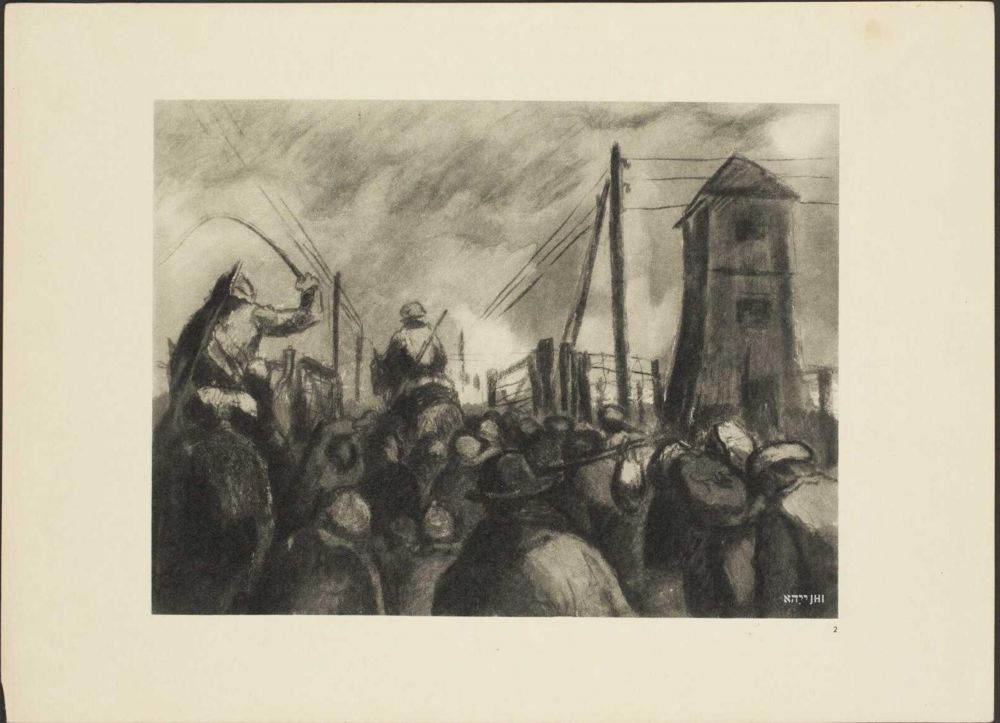- News
- Events
- Oneg Shabbat
- Collections
- Research
- Exhibitions
- Education
- Publishing Department
- Genealogy
- About the Institute
- Bookstore


Zinovi Tolkachev, “Place of no return”, 1945. Portfolio with reproductions of the works of “Majdanek”. JHI collection
Zinovi Tolkachev was born in Belarus in 1903 to a Jewish family, but was associated with Kiev for most of his life. In 1940, he became a professor at the Kiev State Institute of Art.
In July 1944, as a Soviet soldier, he reached the Majdanek concentration camp and extermination centre, and six months later, Auschwitz, where he participated in the work of the commission investigating war crimes. His drawings, which were included in the albums “Majdanek” and “Flowers of Auschwitz”, were presented in the years 1945-1946 at exhibitions in Warsaw, Lublin, Kraków, Rzeszów, Łódź, and Katowice. On behalf of the Polish government, they were sent to the heads of state of the anti-Nazi coalition as a testimony to German crimes.
In the first of the selected drawings (at the top of the article), the author may have wanted to present the arrival of a new transport of prisoners to the camp. At the front, you can probably see the entrance gate to the selection square, the so-called Rosengarten (“rose garden”), which was located next to the barracks of the women’s bathhouse. The luggage was collected from the arrivals at the selection square and divided into two bathhouses: men’s and women’s. This is also where the selection took place: healthy people were separated from the sick and children.
![droga_zw.jpg [493.19 KB]](https://www.jhi.pl/storage/image/core_files/2022/4/5/6749ea538262eb2986fb574685fb2c8b/jpg/jhi/preview/droga_zw.jpg)
In the second picture, we can see a road next to a barbed wire fence. If we compare this drawing with the map of the KL Majdanek camp, we will see that it most likely represents the path to the new crematorium that the Germans built in the autumn of 1943. Its supervisor was Erich Mußfeldt, a baker by profession. A chimney looms in the distance, next to a watchtower. We can try to imagine what the prisoners felt when walking down this way.
![wieże_strażnicze_zw.jpg [488.92 KB]](https://www.jhi.pl/storage/image/core_files/2022/4/5/e693aaff3ae8439ad11ea25db7824317/jpg/jhi/preview/wieże_strażnicze_zw.jpg)
The third picture perhaps shows the main camp road. The watchtowers stand in a row like ancient siege towers – however, they are not meant to destroy the fortifications, but to keep the prisoners in fear and obedience.
![dozorczyni_zw.jpg [494.36 KB]](https://www.jhi.pl/storage/image/core_files/2022/4/5/e2b91d3def99cf36efdae73da4903ec0/jpg/jhi/preview/dozorczyni_zw.jpg)
The woman shown in the fourth drawing does not resemble any of the female guards who worked at Majdanek. She wears a female uniform and holds a whip in her hand – a tool for beating prisoners that often flashes back in their memories.
Although Tolkachev was a member of the communist party, for many years associated with Soviet rule, after the war, on the wave of Stalin’s anti-Semitic campaign, he was accused of “cosmopolitanism”, “bourgeois nationalism” and creating “Zionist-religious” works.
He died in 1977 in Kiev. After his death, his descendants donated the drawings to the Yad Vashem Institute. In the collection of the Jewish Historical Institute there is a copy of the “Majdanek” portfolio from 1945, which you can see in its entirety on the website of the Central Judaic Library.
Thanks to Małgorzata Smreczak for help in captioning the drawings